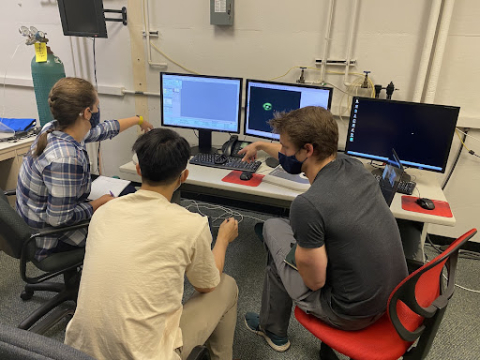In the Swagelok Center for Surface Analysis of Materials (SCSAM) at Case Western Reserve University, we rely on a novel method of providing researchers on campus access to the capabilities of a of transmission electron microscopy (TEM) while also being a responsible steward of the federal, state, and industrial funds that are needed to purchase and maintain these technologies. We leverage the existing fiber optic connection between CWRU and The Ohio State University that already enables researchers across the State of Ohio to utilize the Ohio Supercomputer Center located on the OSU campus to also gain remote access to Ohio State University’s TEM Facilities at the Center for Electron Microscopy and Analysis (CEMAS). This humble looking remote access station, though dwarfed in size compared to the two-story TEM that graced the CWRU campus community in 1970 provides CWRU researchers cost-effective access to world-renowned, state-of-the art instruments. This ushers in a potential transformative era for microscopy research centers in Ohio where the internet-of-things allows researchers across Ohio to gain access to the specialized instruments at other institutions that have capacity that exceeds the home institution's user base. In this way, the universities in the state of Ohio are no longer competing against each other for federal funding for instruments but all gain when one wins.
Training
Since the instruments that we have access to are at Ohio State University, we rely on their research staff to train new users. Training is done for Ph.D. students by enrolling in the TEM practical course offered each semester virtually by OSU. Ph.D. students interested in being trained on the instruments should contact the SCSAM Executive Director, Jeffrey Pigott (jxp652@case.edu) to be added to the list for the following semester offering. Enrollment and tuition fees can be paid using discretionary funds (e.g., OPRs, startups, endowments, etc.) but cannot be paid for using sponsored research funds. Credit for the 2 credit course is transferable for CWRU credit. Credit toward the Ph.D. graduation requirements is dependent upon the individual student, department, and grad studies committee. Other types of researchers (i.e., Post-Doctoral or Research Associates) should contact OSU CEMAS staff directly to determine a method of training.
Logistics
Sample Shipping
Samples need to be provided to SCSAM Staff, by 12pm three days before the scheduled CEMAS time. Since CEMAS TEM time is often booking two-weeks in advance, this should not be an inconvenience. Please inform the SCSAM staff if you want the samples returned to you after the session.
Registering on CEMAS and SCSAM Schedulers
Students request an OSU “sponsored guest account” at the CEMAS site. That will give them a name.## username and password. They then will register within the FOM.osu.edu scheduling system.
Register as a user on iLab, with your PI’s group (following the instructions on the training protocols). Create an iLab project request for TEM and provide the SCSAM Executive Director your OSU name.
Registering for Time on the Instruments
First, confirm that the TEM and the remote access console are available in the CEMAS FOM system. Register for time on both instruments and then confirm that the Instrument Manager is available to load/unload samples during the requested hours. Once you have confirmation from the CEMAS Instrument Manager that your time is a go, schedule time on the representative machine in SCSAM-iLab.
Cost
The SCSAM facility has real cost associated with hosting this remote access to the CEMAS facility. For your convenience they are listed below:
- A recurring site license for maintaining a secure, effective work station
- Pre-purchase the batch of hours on TEM’s at CEMAS
- Shipping of samples to-from the centers
The hourly rates are posted on the SCSAM website.

